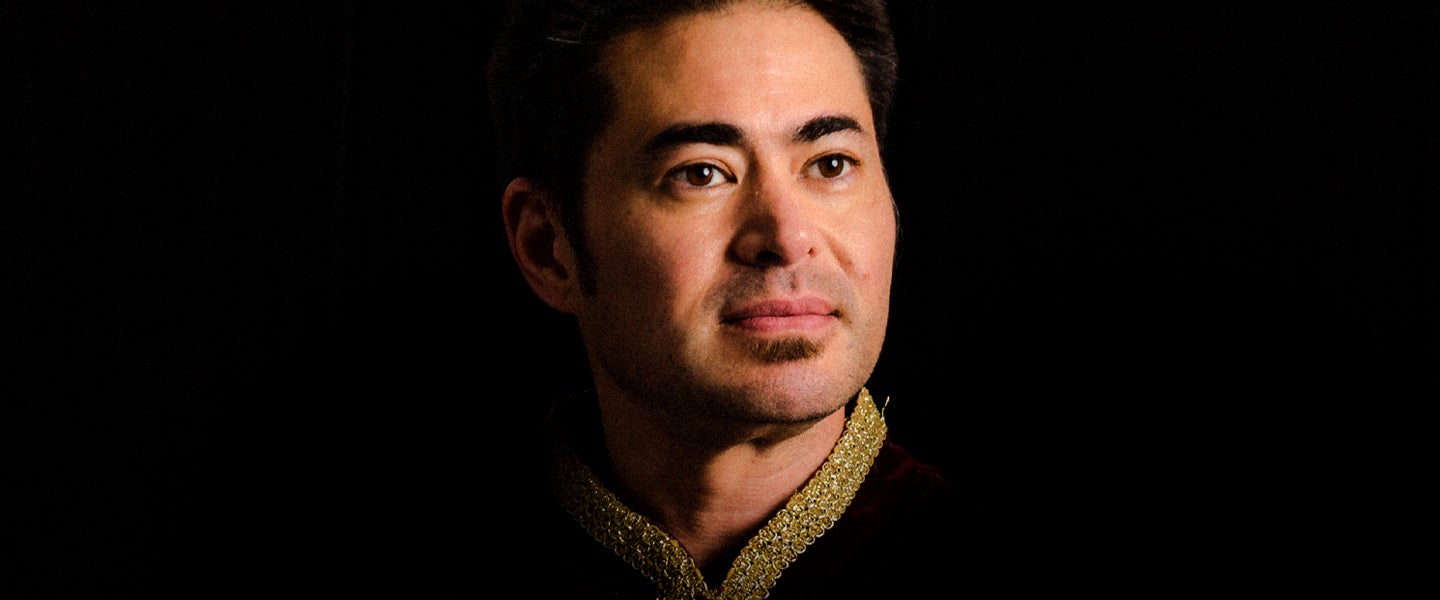It’s easy to miss the seahorse décor if you’re not looking. When I first enter the Beatie home in Phoenix, the seahorse statue on the side table in the entryway escapes me while 9-year-old Jensen summons his dad from the top floor of their split-level home. Had I craned my neck to follow Jensen’s descent back downstairs, I could’ve caught a glimpse of a jewel-tone painting overlooking the Beaties’ fish tank — another piece of seahorse artwork gone unnoticed.
I don’t catch on to the marine motif until I’m presented with a photo of Thomas Beatie’s wedding cake. Beatie, 45, and his wife, Amber, 48, now married for almost half a decade, provide commentary as we sit in their living room and flip through a photo album replete with images chronicling their wedding day. The rhythmic outpouring of nostalgia (theirs) and compliments (mine) comes to a halt when we arrive at a page featuring photos of the cake, multi-tiered and bronze, with two ivory-colored seahorses forming a heart at the top.
Though the cake wasn’t any good — too much emphasis on the “salted” part of “salted caramel,” Amber explains, making a yuck face — they still have the topper. Beatie points me toward the half-wall that separates the living room from the kitchen. Sure enough, in a glass jar among other beads and baubles are those same white seahorses, locked in an endless smooch.
“The male seahorse carries the baby, so that’s always been our theme,” Beatie tells me, smiling.

You might not know Thomas Beatie by name anymore, but you’ve probably heard of him. Better known as “The Pregnant Man,” in 2007 and 2008, Beatie’s face — and more to the point, his pregnant body — was plastered across every magazine sold at the end of grocery checkout aisles throughout the country. The story of his pregnancy was big news in Germany and the U.K., too, and paparazzi from outlets domestic and international stalked him outside his home for months, trying to snap a photo of the man who would give birth.
My favorite image of Beatie from that era, however, isn’t the one of him that’s also the first hit on a Google image search for “pregnant man.” It’s not the now-iconic picture that ran alongside his original op-ed in the Advocate, the article that kicked off the ensuing media frenzy, featuring Beatie bearded, shirtless, displaying his top surgery scars and touching his pregnant stomach. Nor is it the sequel to that image that ran in People magazine displaying Beatie in a similar pose, still shirtless, but further along in his pregnancy and with better lighting. The image I love most is from the Telegraph and looks awful. It’s obviously shot from a distance, maybe from a vantage point of a neighbor’s hedge or a surreptitiously parked car. In the photo, Beatie is some six weeks shy of his due date, sporting a big grey T-shirt over his baby bump, wearing dark shorts and the kind of sunglasses you’d wear to do yard work. He’s holding a weed-whacker and looking off in the distance, like a dad-to-be about to do some chores — because that’s precisely what he is.

Today, his haircut is similar to the one he had in that Telegraph photo, though his dark hair is starting to grey at the temples. But he’s definitely more fit than the man holding the string trimmer in the photo, having resumed his regular hormone replacement therapy (HRT) regimen after five years without the weekly testosterone injections he, like many trans men, administer as part of their physical transition. Beatie, who has been out as a trans man since the late 1990s, took a half-decade hiatus from HRT so he could carry and give birth to three kids in just over three years. Now, he’s replaced the big grey T-shirt with a form-fitting black one that reads BODYBUILDER.COM across the chest. And rather than covering a pregnancy, it shows off his toned biceps.
As we spend the entire morning and much of the early afternoon talking in his living room, Beatie, a stockbroker at an investment management firm, is lounging in a recliner in American-flag-printed board shorts. Family members duck in and out, with Amber offering me a PowerBar, crackers and juice box. Is this really the source of the spectacle that caused so much controversy in the late aughts? Is this the Radical Transsexual Family that rocked Americans’ perceptions of gender norms with appearances on Oprah and televised interviews with the likes of Anderson Cooper and Barbra Walters?
It’s difficult to reconcile Beatie’s typical, 9-to-5 married-with-kids suburban existence with the knowledge that how he created his family, and how they continue to thrive, is something remarkable, something worthy of note in the course of transgender history.
That said, Beatie isn’t the first transgender person whose reproductive capabilities made headlines. Christine Jorgensen landed in New York in 1952, fresh off a trip to Europe where she underwent a host of cutting-edge gender confirmation surgeries. As queer historian Hugh Ryan tells it, “On December 1 1952, the cover of the New York Daily News blared, ‘EX-GI BECOMES BLONDE BEAUTY,’ and an icon was born.” Jorgensen was nationally famous, and briefly, naturally beloved — until the American people caught wind that, though science could deliver us the atom bomb and the microwave oven, we hadn’t yet worked out how to implant a functioning womb in a woman who was born without one. Public opinion on Jorgensen swiftly shifted. Again, Ryan says it best: “In the eyes of the public, Jorgensen was no longer a man-made woman, but a gender terrorist in a blond bouffant.”
Fifty years after Jorgensen was scorned for her sterility, the New York Times ran with a similarly melodramatic headline about Beatie: “He’s Pregnant. You’re Speechless.” Even in 2019, the Times doesn’t have a sterling record on covering trans people and issues, but the 2008 article is an interesting artifact from a time before the putative “transgender tipping point,” a crucible through which the American public is said to have already passed, as evidenced by how everyone is now extremely educated and chill about all things trans. Eleven years after this article was published, mainstream news coverage on trans issues is… better, maybe? Different, at least? More likely to assume people know what “transgender” means while debating if trans folks should be allowed to use the same bathrooms, play the same sports or exist at all?
“I immediately felt a sense of profound empathy for Thomas,” Trystan Reese, the director of family formation at Family Equality, tells me about the media frenzy over Beatie’s 2008 pregnancy. “I knew that he, and other transgender people, would be subjected to an immense amount of scrutiny and transphobia. And much to my sadness, I was right. He was lambasted on late-night television shows and bore the brunt of short-sighted, bigoted ‘comedy’ across media outlets.”

Some reporters who covered Beatie during his first public pregnancy don’t disagree with Reese’s assessment. Tom Leonard, a New York-based reporter for the Daily Telegraph at the time, wrote a story for the publication when Beatie gave birth. Though he stresses to me that his Beatie coverage was off of his beat and the two men never met, Leonard tells me, “At the time I was skeptical, and my views haven’t changed. It seemed like a publicity stunt. I think others were skeptical too, and I suspect they thought it was all rather weird and freakish.”
While Leonard’s view on Beatie hasn’t budged in the intervening years, Reese tells me he’s grown more sympathetic. (Originally, he says, “I felt it was too soon for a trans pregnancy story to go public at the time; developmentally, Americans just weren’t ready for it.”) “I just wish it hadn’t been so hard on him and the rest of the trans movement. I wish there had been more support in place for him, so he could have had the resources to educate journalists ahead of time, to know how to interrupt their inappropriate questions and hold them accountable for inaccurate and irresponsible reporting. That must have been so hard for him to experience.”
By Beatie’s account, public opinion about trans people — or at least about him — has improved since 2008, but only slightly. “Back then it was 99.99999 percent terrible. Today, it’s only maybe 95 percent terrible,” he says from his reclined position in his sand-colored armchair. He’s specifically referencing his assessment of the comments section of any American news site (“if you read the comments, which you should never do”), where a story about him pops up. “If you’re the subject matter of the topic, you can’t not read the comments, and you go straight to it ’cause you want to know how people are reacting,” he explains. “So obviously I’d read the comments on the articles written about me, and they were to no end negative.”

Beatie ascribes this negativity to Americans, specifically, because he feels he’s been embraced in other countries. In fall 2016, for example, Beatie participated in a French reality TV show called Secret Story, a Big Brother-style contest where a surprising amount of fan support earned him a second-place finish. (He and Amber believe Beatie should’ve won, but suspect the powers that be behind the scenes prevented an American contestant from winning.)
Taping the show took Beatie away from his family for three months, a long separation for a recently remarried man and dedicated father who spends “hundreds of hours” annually pulling together a photo album culled from cellphone shots of his family’s previous year together. Beatie credits his commitment to photo documentation as a reaction against his own father’s parenting style. “He’d take pictures and then those pictures disappeared. They were left in cameras undeveloped. Then he died, and then we lost everything. So you take the pictures, you cherish them and you put them in a way that people can enjoy them and look at them.”
After the wedding album, we look at more recent family photos: Several depict Beatie’s oldest child, Susan, now 11, leaping midair during an Easter-egg hunt. (Amber: “You know why we catch her in motion?” Beatie and Amber, simultaneous: “’Cause she’s always in motion.”) There are photos of Beatie and Amber in Hawaii after Beatie’s mostly estranged father passed away in 2015. From more recent, happier times, we review pictures of Susan, Jensen and Austin (10), and Susan embracing newborn baby Jackson, Beatie and Amber’s youngest child, and thus far the couple’s only offspring together.
Jackson, now 15 months old, is napping in the next room. Unlike the other three Beatie kids, Beatie didn’t carry him to term: Amber did, with the help of an implanted embryo created from an egg donor and the same sperm donor who provided the assist with Susan, Austin and Jensen. “It was the easiest pregnancy that I ever had, so much so I’d like to do it again,” Beatie says. Amber shoots him a look, so he continues: “No, it was definitely different. It was cool that I didn’t have to go through the physical changes and stuff, because man, when you’re pregnant, every day seems like an eternity.”
Beatie tells me he didn’t experience dysphoria as a pregnant man — as in, it didn’t impact his gender identity or sense of self as a father — but we did discuss some of the impacts being off of testosterone had on his body during the stretch of time when he was consistently pregnant. He likens looking at pictures of himself while pregnant to face filters on apps like Instagram. “I still have the same [facial] structure as always, but off of testosterone, my features are rounder. It’s like my face isn’t as angular.”
“The appearance of the skin is one factor that makes people have a judgment [about his gender identity] either way,” he continues. “It’s kind of weird when I look at pictures of myself pregnant, I’m like, ‘Oh my god, I look like Liberace. What is going on?’”
While Beatie, Amber and I talk, the eldest three Beatie children flit in and out of the living room, variously scooping up one of the family’s two Himalayan cats or procuring permission for neighbor kids to come over and play downstairs. Austin, who speaks with a rapid, recursive speech pattern when he thinks faster than he talks, which is most of the time, challenges me to a game of chess. He dispatches me in six moves.

Surfacing from the home’s lower level to be Austin’s next opponent is Jensen. They battle it out far longer than I could manage, but Austin ekes out a second win over his younger brother. Because Jensen’s ninth birthday was just a few days earlier (Austin and Jensen are almost exactly one year apart in age), the Beatie Bunch has plans to go to lunch together to celebrate.
Once baby Jackson stirs from his nap, preparation for departure begins. A carseat is located, a baby bag inspected and repacked. Neighbor kids are sent home. The addition of my coming along for the ride means the entire family can’t fit in the SUV, as is the norm; Amber and Beatie decide to take two cars, sparking a debate among the elder Beatie kids on who will ride with which parent and who will get front-seat privileges. (They concede that I, an adult man, should probably be allowed to sit shotgun alongside their dad.)
Finally, we drive off to lunch, Beatie, Austin and I in a light-colored sedan, trailing behind Amber and the others in the SUV. Ten minutes into the drive, the SUV pulls off the highway and onto a side street. Beatie follows and parks behind her. I raise my eyebrows at this, but Beatie assuages my concern, telling me it’s probably just something with the baby — maybe Jackson dropped his bottle, etc. On cue, Amber hops out of the SUV, makes a silly face at Beatie, handles some business with Jackson in the back seat, and we’re back on the road.
Five minutes later, the SUV pulls the same maneuver. It’s Beatie’s turn to look concerned: We’re within sight of the restaurant, so why pull over now? Amber doesn’t hop out of the SUV this time. Instead, Beatie’s phone rings. “That’s not good,” he says, shortly before the call ends. He takes a beat between putting away his phone and making an announcement to me and Austin. “We forgot Jensen at home,” Beatie says. He pulls a U-turn. “This is so bad. This has never happened before.”
“This is embarrassing,” Austin adds.
“Great, he’s gonna go back to my ex and tell her.”
Even a common sentiment like this — not wanting his kid to tell his ex about a dumb mistake the next time he drops them off at her place — has an uncommon path to fruition, though it seems like a typical divorce dynamic.
Follow me down the rabbit hole of transgender case law: Beatie and his now-ex-wife, Nancy, were married in Hawaii in 2003. Thomas Beatie was already legally a man, as far as the state was concerned — his driver’s license, social security info, even birth certificate had been updated to reflect his identity — so the legality of same-sex marriage wasn’t an issue. Beatie and Nancy then move to Bend, Oregon, where Susan, Austin and Jensen were all born, with Beatie listed as their father and Nancy as their mother. Great, all reasonable, everything’s cool here, sure. Next, the family moves to Arizona. Beatie and Nancy’s marriage dissolves, and they file for divorce in 2012.
This is where things start getting Kafkaesque.
Arizona says they can’t get divorced because they’re not married. Beatie and Nancy say, “Well, unfortunately, yes we are.” Arizona says, “You’re both women, and women couldn’t be married in 2003, so you’re not married.” Beatie says, “No, I’m legally a man, and we were legally married, so we need a legal divorce.” Arizona says, “You can’t get a divorce; you were never really married.” And so on and so on and so on.
Beatie and Nancy finally secured their legal separation in 2015, and he’s proud of the precedent his case set. “I was very ‘thank god’ about the fact that we won and got to get the divorce, [to] solidify that, hey, there are trans people, trans men who can get pregnant, give birth. It’s valid. Doesn’t make you any less of a man. Doesn’t make you any less of a husband. [It was] so huge to me, and hopefully to other people as well.”
Beatie’s rights as the father of his children have, so far, been protected. But just last month, Freddy McConnell, a U.K. citizen and trans man who gave birth, was denied the right to be registered as his child’s father. Instead, the courts have stuck him with the “mother” designation. (The documentary released about McConnell’s pregnancy is, of course, titled Seahorse.)
To hear Beatie tell it, though, his case was a pyrrhic victory. “You want to know the irony of it all? That’s what I fought for. I fought for the right to have joint custody with my ex-wife. I would’ve gotten full custody if our marriage wasn’t validated. She wouldn’t have been seen as a parent.”
Now, though, Beatie is simply worried about what his ex will think about the 9-year-old he left back at home. He spends the rest of the ride processing how the mistake was made (the two cars, both parents assuming the other had the remaining kids) and how Jensen must be feeling (probably not great). For his part, Austin spends the drive back wondering aloud whether or not his younger brother cried when he realized what had happened.
It takes just over 10 minutes to double back and pick up Jensen from the safekeeping of the neighborhood friends’ mom. Beatie apologizes, the family again runs through how it all happened (two cars!), and soon Jensen and Austin are playing video games on their respective tablets in the backseat, drama resolved.
We finally arrive, and lunch at a seafood place passes without incident. Jensen blows out a candle in his brownie-with-ice-cream birthday dessert, and we’re off to the main event: Uptown Jungle Fun Center, a sort of enormous, militarized take on a McDonald’s PlayPlace. Crucially, the place is exquisitely air conditioned, offering Phoenix-area parents a place for their kids to zoom around when the heat hits triple digits, as it has today.
The kids are given wrist bands and let loose among a huge, high-ceilinged grid of rope climbs, foam ball pits, towering plastic slides, tunnels equipped with child-sized machine gun turrets so children can snipe others below with foam balls shot out of small cannons and an endless dodgeball game loosely moderated by a Jungle staff person. Susan, Jensen and Austin scatter. There’s a special 5-and-under section of the Fun Center with less-warlike fare for the toddler set, but Jackson, renewed after his nap and lunch, seems more interested in the open spaces around the facility to test out this new “running” thing he’s gotten into lately.
Beatie and I stand off to the side and watch Amber follow their 15-month-old as he darts around the enormous child gym. The other kids zoom in and out of our view, grinning and panting. Beatie, too, grins almost the entire time. He smiles when we notice Susan has recruited a new friend midway up a rock wall. He smiles when he points out that Jensen is the only kid whose face flushes red with exertion (Susan and Austin have darker complexions, darker hair). He smiles when Jackson rounds a corner with a foam ball in his hand, though Amber just removed a different foam ball from his grasp seconds ago.
He’s a dad, and he loves doing Dad Stuff like this, spending an afternoon with his kids in an Equinox by way of Chuck E. Cheese.
The only time Beatie’s smile fades is when our discussion turns to the prospect of future children. Jackson was one of a half-dozen or so embryos Amber and Beatie had created; the selection of the embryo that would become Jackson, the Runningest Toddler in Phoenix, was totally random. Now the Beaties pay about $1,500 a year to keep the remaining embryos in storage. Beatie calls them “more than possibilities,” but the options for transforming any of them into the fifth Beatie child are diminishing. After giving birth to three kids in three years, Beatie’s stomach muscles were damaged, and he had to have corrective surgery. That aside, he and Amber are both in their late 40s. He knows getting pregnant wouldn’t just be difficult for either of them, it might be impossible.
He catches himself while talking this through: “Man, that’s heavy.” It’s the first time I’ve seen him express anything besides total confidence in himself, or at least optimism, all day. He’s conquered physical challenges from beauty pageants to bodybuilding to three nearly consecutive pregnancies. He achieved his dream of fatherhood by publicly taking on a responsibility that’s nearly synonymous with motherhood.
Beatie’s gender identity didn’t stop him from creating a family on his terms, and a harsh national spotlight didn’t deter him either. But for the first time, Thomas Beatie is dealing with limits he may not be able to subvert or overcome: a finite amount of money and a finite amount of time. I try to make a joke, suggesting that compared to these decisions, his midlife crisis will be a breeze. He responds immediately.
“Man, I’m already in it.”

